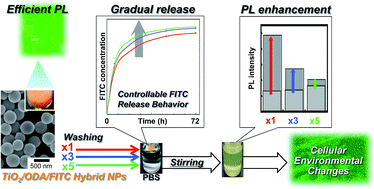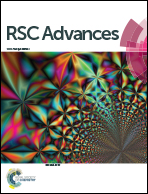Preparation of luminescent titania/dye hybrid nanoparticles and their dissolution properties for controlling cellular environments†
Abstract
To design non-cytotoxic controlled release system is one of the major challenges in such a field as biomedicine. For this purpose, well-defined, luminescent and cytocompatible titania/dye hybrid nanoparticles (NPs) are synthesized. Hybrid NPs with a uniform size/shape are achieved through the precisely controlled microfluidic hydrolysis and co-condensation reactions of titanium tetraisopropoxide and 3-aminopropyltriethoxysilane in the presence of octadecylamine (ODA). By adding the cell-staining luminescent dye of fluorescein isothiocyanate (FITC) molecules to the starting solution, the spherical titania/aminopropyl-silica/ODA/FITC hybrid NPs (average diameter: 400 nm, coefficient of variation: 9.5%) are successfully prepared. Interestingly, the NPs demonstrate enhanced luminescence after treating them with phosphate buffered saline (PBS) and a possible mechanism is discussed. These NPs are not dispersed in PBS during the treatment due to their hydrophobic surface, which is an important feature to avoid cytotoxicity caused by an endocytic pathway. The NIH3T3 fibroblast viability test revealed that the hybrid NPs are not cytotoxic, realizing the clear imaging of the cellular shapes by the cellular gradual reactions mainly with the FITC released from the hybrid NPs floating at the interface. Therefore, the well-defined hybrid NPs with tailored surface/release properties are promising candidates for slowly-controlling cellular environmental systems (e.g., drug delivery systems).


 Please wait while we load your content...
Please wait while we load your content...